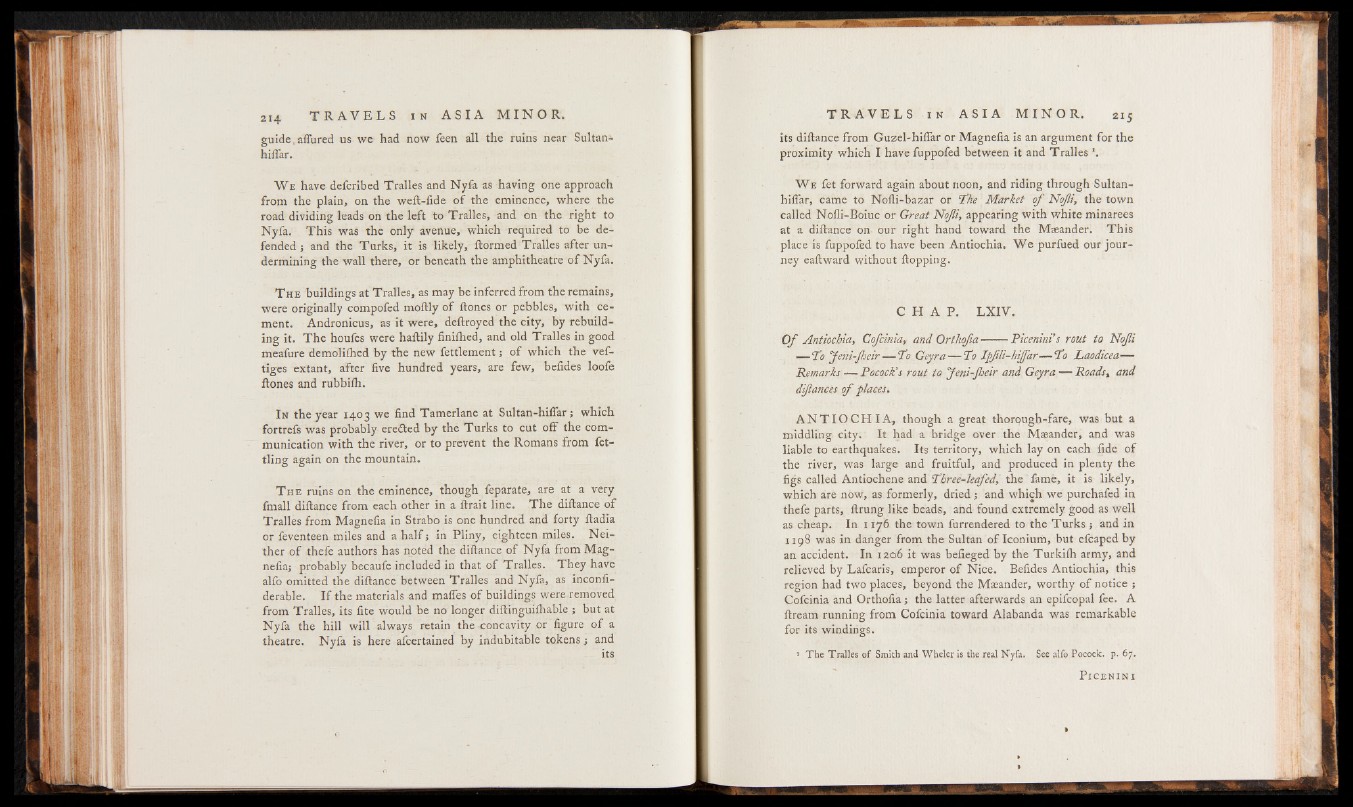
guide,allured us we had now feen all the ruins near Sultan-
hifiar.
W e have defcribed Tralles and Nyfa as having one approach
from the plain, on the weft-fide of the eminence, where the
road dividing leads on the left to Tralles, and on the right to
Nyfa. This was the only avenue, which required to be defended
j and the Turks, it is likely, ftormed Tralles after undermining
the wall there, or beneath the amphitheatre of Nyfa.
T h e buildings at Tralles, as may be inferred from the remains,
were originally compofed moftly of Hones or pebbles, with cement.
Andronicus, as it were, deftroyed the city, by rebuilding
it. The houfes were haftily finilhed, and old Tralles in good
meafure demolilhed by the new fettlement; of which the vef-
tiges extant, after five hundred years, are few, befides loofe
Hones and rubbilh.
I n the year 1403 we find Tamerlane at Sultan-hifiar; which
fortrefs was probably eredted by the Turks to cut off the communication
with the river, or to prevent the Romans from fettling
again on the mountain.
T h e ruins on the eminence, though feparate, are at a very
fmall diftance from each other in a ftrait line. The diftance of
Tralles from Magnefia in Strabo is one hundred and forty ftadia
or feventeen miles and a half j in Pliny, eighteen miles. Neither
of thefe authors has noted the diftance of Nyfa from Mag-
nefiaj probably becaufe included in that of Tralles. They have
alfo omitted the diftance between Tralles and Nyfa, as inconfi-
derable. I f the materials and mafles of buildings were removed
from Tralles, its fite would be no longer diftinguiihable 5 but at
Nyfa the hill will always retain the concavity or figure of a
theatre. Nyfa is here afcertained by indubitable tokens •, and
215
its diftance from Guzel-hiflar or Magnefia is an argument for the
proximity which I have fuppofed between it and Tralles '.
W e fet forward again about noon, and riding through Sultan-
hifiar, came to Nofli-bazar or Phe Market o f No/Zi, the town
called Nolli-Boiuc or Great Nofli, appearing with white minarees
at a diftance on pur right hand toward the Msander. This
place is fuppofed to have been Antiochia. We purfued our journey
eaftward without flopping.
C H A P . LXIV.
O f Antiochia, Cofcinia, and Orthofa------Picenini’s rout to Nofi
— Po Jeni-Jheir— To Geyra— Po Ipjili-hijfar— Po Laodicea—
Remarks — Pocock's rout to Jeni-Jheir and Geyra — Roads, and
diftances of places,
A N T IO C H IA , though a great thorough-fare, was but a
middling city. It had a bridge over the Maeander, and was
liable to earthquakes. Its territory, which lay on each fide of
the river, was large and fruitful, and produced in plenty the
figs called Antiochene and Phree-leafed, the fame, it is likely,
which are now, as formerly, dried ; and which we purchafed in
thefe parts, ftrung like beads, and found extremely good as well
as cheap. In 1176 the town furrendered to the Turks ; and in
1198 was in danger from the Sultan of Iconium, but efcaped by
an accident. In 1206 it was befieged by the Turkifh army, and
relieved by Lafcaris, emperor of Nice. Befides Antiochia, this
region had two places, beyond the Maeander, worthy of notice ;
Cofcinia and Orthofia j the latter afterwards an epifcopal fee. A
ftream running from Cofcinia toward Alabanda was remarkable
for its windings.
» The Tralles of Smith and Wheler is the real Nyfa. See alfo Pocock. p. 67.
P l C E N I N I